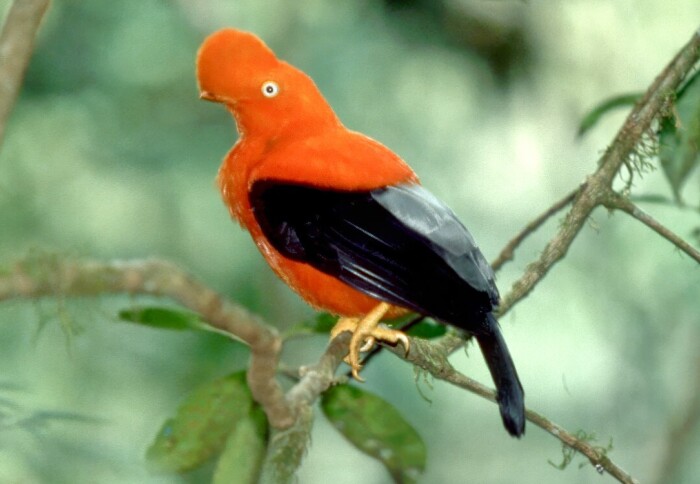Climate determines mating behaviour of birds around the world
by Emily Govan

Andean Cock-of-the-rock, Manu National Park, Peru (Credit: Joe Tobias)
A new study published in PLoS Biology reveals how sexual selection in birds varies geographically, often peaking at higher latitudes.
The evolution of sexual signals and displays – including the flamboyant tail of the peacock and the song of the nightingale – has long been a source of fascination to scientists. How these displays vary across animals is driven by an evolutionary process called sexual selection, which tends to be muted in monogamous species with long-term sexual partnerships, and much stronger in species with more extreme forms of polygamy, promiscuity and skewed sexual roles.
A vast amount of research has investigated variation in sexual selection within populations but we know much less about why so much variation exists between different species across the globe.
"These findings help to resolve a longstanding disagreement about whether sexual selection peaks in the tropics or towards the poles. The unexpected answer is that opposite patterns can be found depending on the food birds eat." Professor Joe Tobias
Now a team of researchers headed up by Dr Rob Barber and Professor Joe Tobias, involving several post-graduate students at the Department of Life Sciences’ Silwood Park, including Jingyi Yang, Chenyue Yang and Oonagh Barker, has addressed this question by collecting data on 10761 species of birds. The team used field observations and published information on mating systems, including levels of polygamy and extra-pair paternity, to estimate the intensity of sexual selection worldwide.
Their findings, published this week in PLoS Biology, showed that the strength of sexual selection increases at higher latitude for most birds, whereas the opposite is true for specialist fruit-eating birds, most of which live in tropical forests where fruit is available all year round.
Professor Tobias said: 'These findings help to resolve a longstanding disagreement about whether sexual selection peaks in the tropics or towards the poles. The unexpected answer is that opposite patterns can be found depending on the food birds eat.'
'In the case of fruit-eating birds, sexual selection is highest in the tropics, perhaps because fruit is so abundant in tropical ecosystems that male birds can ditch parenting and invest all their effort in mating with as many females as possible – hence the gaudy plumes of birds-of-paradise and cocks-of-the-rock.'
The study also shows that the intensity of sexual selection in birds can be explained by temperature seasonality as well as other climate-related factors, which together explain why sexual selection peaks towards the poles in most bird species.
"Our research provides new, global-scale evidence that environmental factors linked to climate determine the level of mating competition within and between the sexes, and also show that this effect depends on species ecology, particularly diet." Dr Rob Barber
In these higher latitudes, highly seasonal climates lead to food shortages during winter, when survival is the priority and the weather is unsuitable for raising offspring. For birds, this means short, intense breeding seasons in summer with increased potential for some high-quality individuals to mate with multiple partners, increasing the strength of sexual selection.
Dr Rob Barber, who led the study as part of his PhD, said: 'Climate and diet play crucial roles in many ecological processes, yet evidence for their influence on mating behaviour and sexual displays has largely come from theoretical models and studies of individual species.'
'Our research provides new, global-scale evidence that environmental factors linked to climate determine the level of mating competition within and between the sexes, and also show that this effect depends on species ecology, particularly diet.'
Overall, these findings help to clarify how climate and ecology shape geographical variation in evolutionary processes linked to reproductive biology, which in turn may help us to understand and predict how species traits and behaviours will respond to changing climatic conditions. To these ends, the study also contains a huge open-access global dataset of sexual selection scores for all birds, representing a vital resource for the international research community, providing information that can be applied to a wide range of research questions in evolutionary ecology and global change biology.
Article text (excluding photos or graphics) © Imperial College London.
Photos and graphics subject to third party copyright used with permission or © Imperial College London.
Reporter
Emily Govan
Department of Life Sciences